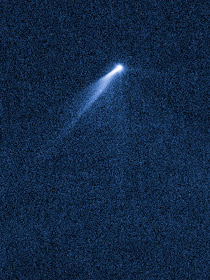Cbet nr. 3639, issued on 2013, August 27, announced the discovery of a new comet (discovery magnitude ~20.9) in CCD exposures obtained on August 15 by the Pan-STARRS1 telescope on Haleakala. The new comet has been designated P/2013 P5 (PANSTARRS). According to the description in the CBET, the object has a nuclear condensation with a stellar appearance and a thin tail that extends for approximately 30" towards position angle approximately 255 degrees.
Orbiting at the inner edge of the main asteroid belt, with semimajor axis, eccentricity and inclination of 2.189 AU, 0.115 and 5.0° , respectively, the Tisserand parameter relative to Jupiter is TJ = 3.66. So this object belongs to the newly recognized class of body in the solar system known as active asteroids or main-belt comet - MBC. These objects are remarkable for having both the orbital characteristics of asteroids and the physical characteristics of comets: they look like comets because they show comae and tails but they have orbits interior to Jupiter's and Tisserand parameters substantially larger than 3, like asteroids. While some are suspected to contain water ice whose sublimation is responsible for the expulsion of dust, others are impact-produced while, for a majority, the origin is unknown. (see also our previous post about P/2012 T1 (PANSTARRS) & 596 Scheila).
Astronomers using NASA's Hubble Space Telescope have imaged P/2013 P5 on UT 2013 Sep 10 and 23, obtaining a total of 12 images with the WFC3 camera. It has no less than six dust tails that seem to be forming sequentially.
As an inner-belt asteroid and probable Flora family member, the object is likely to be highly metamorphosed and unlikely to contain ice. The protracted period of dust release appears inconsistent with an impact origin, but may be compatible with a body that is losing mass through a rotational instability. We suggest that P/2013 P5 has been accelerated to breakup speed by radiation torques.
You can read the full Hubble release here or the paper based on these observations here on Arxiv. Below you can see the Hubble images (click on it for a bigger version).
 |
| Credits: NASA, ESA, and D. Jewitt (UCLA) |
 |
| Credits: NASA, ESA, and D. Jewitt (UCLA) |
While below there is a summary of the main properties of active asteroid P/2013 P5 as outlined in the paper by Jewitt et al.
We performed follow-up measurements of this object on November 07. Stacking of 16 R-filtered exposures, 120-sec each, obtained remotely from MPC code E10 (Faulkes Telescope South) on 2013, November 07.4 through a 2.0-m f/10.0 Ritchey-Chretien + CCD (operated by Las Cumbres Observatory Global Telescope Network), shows a thin tail 25" long in PA 75 (magnitude ~21).
Below our follow-up image of P/2013 P5. Click on it for a bigger version.
by Ernesto Guido, Nick Howes & Martino Nicolini



The escape velocity from a rocky asteroid with a radius of 240 meters will be roughly 0.240 meters (9.4 in) per second.
ReplyDelete